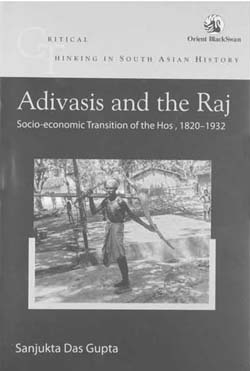In 1981, the Kolhan Raksha Sangh, an adivasi political organization formed in Singhbhum in 1977, declared that Kolhan1 was a sovereign state, independent from India. A delegation of the representatives of this ‘Kolhan republic’ went to Delhi, and thereafter to England. The delegates claimed that Kolhan was legally outside India’s territory and was entitled to self-government under Wilkinson’s Rules since there was no official document of merger between Kolhan and the State of India.
Sanjukata Das Gupta concludes with this story her monograph, Adivasis and the Raj, Socio-economic Transition of the Hos, 1820– 1932, as she looks for an explanation of these developments in the colonial past. The implementation of Wilkinson’s Rules that had upheld the manki-munda2 system for governance, she argues, had legitimized British rule, and many advocate, even today, the efficacy of British administration. The administrative policies of the colonial government, Das Gupta suggests, brought the Hos together under one political banner, and ‘resulted in the formation of a geographically more homogenised group, in spite of divided loyalties’ (p. 313). Under British rule, the ‘rebellious Larkas’ of the nineteenth century, were transformed into ‘generally peaceful tenants’ (p. 313). We do not, thus, have instances of Hos rebelling in the early twentieth century, while we do have elsewhere in Chota Nagpur the Birsa ulgulan and the Tana Bhagat movement.
In order to narrate the story of the Ho people of Singhbhum under colonial rule and arrive at a nuanced understanding of the colonial impact, Das Gupta traces in her monograph the nature and characteristics of the pre-colonial village structure of the Hos, and its transformations thereafter under colonial rule. In their encounter with the British, the Hos, like adivasi communities elsewhere, confronted several new challenges relating to a variety of issues: their role in the political system, their right of access to local territory and forest resources, the growing influx of outsiders into their villages, the restructuring of indigenous institutions of authority etc. All these, in turn, impacted upon their notions of self-identity and shaped their socio-cultural and political movements in colonial and postcolonial India. At the level of making a historiographical intervention, Das Gupta argues that while adivasi history has expanded its scope and is no longer restricted to stories of momentous rebellions, much of the recent research has been preoccupied with issues of identity, categories and definitions. In contrast, we know little of certain groups, and what happened to them in changing historical circumstances. Das Gupta intends to fill this lacuna by focusing on the internal life of an adivasi community. In this sense, Das Gupta’s contribution is significant: while monographs on the adivasis are in themselves limited in number, on the Hos, there has been very little research that has been undertaken. This work is thus critical in building our knowledge on the adivasi communities of Chota Nagpur, and especially of the Hos.
The book, divided into eight chapters, with an introduction and conclusion, discusses the village-based social organization of the Hos, and the relations between the first group of settlers, the later settlers and the non-adivasis in Singhbhum, the supravillage power structure, and the changing relations of the Hos with a superior political authority (here the Raja of Singhbhum and his vassals), the impact of colonial intervention—which in turn transformed the Ho socio-economic organization, livelihood patterns and ultimately the village community, the land tenurial rearrangements under colonial rule, while how the administrative changes under British rule redefined the relationship of the Hos with the forest and the agrarian economy. Chapters 7 and 8 explore the changing relations between the Hos and ‘non-Ho outsiders’, that ultimately led to the sharpening of a Ho political identity.

